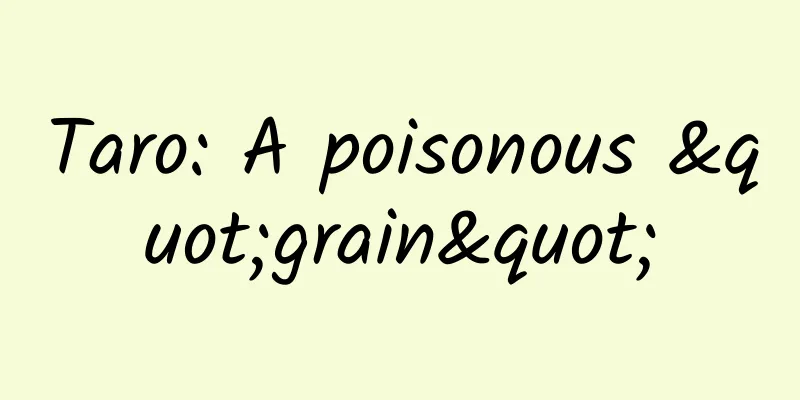Taro: A poisonous "grain"

|
The entire taro plant is poisonous, and even locusts avoid it, but it is an ancient food crop that many tropical ethnic groups still use as their staple food and never get tired of eating. In the past, people in the rural areas of Northwest Fujian used to burn wood stoves. After cooking, there was still some charcoal left. At this time, you could bury a few taro with the skin on and eat stewed taro. Peel off the charred taro skin, and the taro flesh is white, tender and smooth, with a fragrant aroma. Take a bite of it hot, it is crispy and soft, and it is best to dip it in soy sauce. But when I was a child, I lived a hard life and often ate it like this, and the taste is nostalgic. I later learned that this most rustic way of eating is very elegant. In the Tang Dynasty, the monk Lan Can stewed taro with cow dung and gave half of it to Li Mi, who then served as prime minister for ten years. Stewing taro became popular in the Song Dynasty. Su Dongpo wrote "Stewed Taro Post"; Li Gang wrote a poem "Stewed Taro" with the theme of "stirring the fire in a cold stove"; Lu You talked with friends after drinking, and when he felt hungry, he boiled chestnuts and stewed taro, boasting that "the taste is as delicious as bear paws" - the taste is as sweet as bear paws. Image source: Tuchong Creative Taro, also known as taro, is a plant of the genus Colocasia in the family Araceae, native to southern my country, Southeast Asia and India. Early Chinese ancient books mentioned taro as a strange species. The "Shuowen Jiezi" of the Eastern Han Dynasty said: "Taro has large leaves and solid roots, which is scary, so it is called taro." This means that taro has large leaves and numerous tubers, and looks scary. People who see it can't help but gasp. This frightened onomatopeia became the phonetic component of the word "taro". "Historical Records" is also interesting, describing the huge taro head as "squatting chirp" - a squatting hawk. Later, people regarded "squatting chirp" as another name for taro. The main reason why taro is scary is not because of its strange appearance, but because the whole plant is poisonous and should not be touched. Araceae is a famous "poison nest". Among them, the familiar Pinellia, Monstera, Calla Lily, Taro, and Konjac are all poisonous and need to be handled with caution. The Tang Dynasty's "Newly Revised Materia Medica" warned: "Taro, spicy... poisonous." Wang Zhen's "Book of Agriculture" in the Yuan Dynasty said that where locusts go, grass leaves will disappear, "but they will not eat taro." You see, even locusts know to avoid taro. The flowers, leaves, and stems of taro are all poisonous. The toxic substance is mainly calcium oxalate in the juice, which will cause itching and redness in human contact. After countless generations of cultivation, the toxicity of taro has been greatly reduced. The simplest way is to remove the poison through high-temperature cooking. Raw taro is poisonous and cannot be eaten; uncooked taro will numb the tongue; taro must be fully cooked to eliminate the toxicity before it can become a delicacy. It should also be noted that wild taro (calla lily), which is similar to taro, is highly poisonous and cannot be eliminated by cooking, and may be fatal. I remember peeling raw taro or cutting taro leaves into pork dishes, and my hands were stained with taro juice, which was hot, spicy, and itchy. According to the saying in my hometown, this is being "bitten" by taro. Unfortunately, hands bitten by taro are contagious, and wherever the skin is touched, it will itch. Washing hands with water is useless. The best way is to put these hands on the stove to roast - also a high-temperature disinfection. The main planted species in Northwest Fujian is multi-seed taro, commonly known as vegetable taro, which is eaten as a vegetable. Under each taro plant, there is a mother taro (Kui taro) and a group of child taro. Liang Kejia, a Song Dynasty writer, wrote in "Sanshanzhi" that "the small ones are like eggs, growing next to the Kui, and are especially delicious to eat." This is a description of multi-seed taro. Steam the egg-sized child taro, peel it, and it will be soft and smooth. Whether it is braised or mashed and cooked into soup, it is invincible. The fiber of taro is coarse and some people feed it to pigs. I think it is especially appetizing to cut it into thin strips and stir-fry it with meat. I can't buy taro in the vegetable market in Xiamen. I only eat it occasionally when I return to my hometown. The taro strips have a sense of vicissitudes, thick and sticky, and are very chewy. There is also a large taro in the northwest of Fujian, commonly known as the betel nut taro, which has only one large female taro on the whole plant. Betel nut taro is relatively expensive, sweet and sticky, crispy and delicious, but not suitable for cooking into home dishes. After moving to Xiamen, I found that all the betel nut taro grown in the southern part of Fujian is very strong and can be used as a meal after steaming. It turns out that betel nut taro is not suitable for eating with rice because it is a kind of "rice" itself. The taro bulb contains a lot of starch, which can satisfy hunger. It is an ancient food crop. After the emergence of cultivated rice, rice became the staple food of southerners, and taro became a coarse grain or vegetable. Su Song of the Northern Song Dynasty said in "Illustrated Materia Medica" that taro was planted in Fujian and other places in the south, "as food to survive famine years." Li Diaoyuan of the Qing Dynasty wrote a poem: "Planting vegetables and taro can prepare for bad years." Only in times of famine will we remember that taro can also be eaten as a meal. Taro is easy to grow and has a high yield. It is used as a staple food by many tropical ethnic groups, who never tire of eating it. "Ten thousand families are well fed with taro rice," wrote Yang Jun, a Taiwanese poet in the Qing Dynasty. According to Qianlong's "Revised Records of Taiwan Prefecture," the ethnic minorities in Taiwan only grow taro, "the largest ones weigh seven or eight kilograms, and they are gathered as food." In Pacific island countries such as Samoa, Tonga, and Nauru, people still eat taro as their staple food and are very fat. When I was a child, I also ate taro stems. This thing is usually used as pig food. Sometimes when there is really no vegetable at home, we compete with pigs for food. Peel the fresh taro stems, cut them into oblique slices, put them into the pot and boil them for a while, then pick them up and stir-fry them with green peppers to make a soft small dish. I often tell my friends about the experience of eating taro stems. As I recall them again and again, its taste becomes more and more delicious. Once, I accidentally encountered this dish in the "Nongjiale" restaurant, and I couldn't swallow it. From then on, I stopped thinking about it. Many good memories in life don't need to be revisited. The article is produced by Science Popularization China-Starry Sky Project (Creation and Cultivation). Please indicate the source when reprinting. Author: Xiao Chunlei, humanities and geography writer Reviewer: Wang Kang, Director of Beijing Botanical Garden Science Center, Professor-level Senior Engineer |
<<: Can you really lose weight by not eating staple foods? You’re overthinking!
>>: [Smart Farmers] What exactly is the “human pneumovirus” that has been frequently searched?
Recommend
Is it expensive to join the Hami Underwear Mini Program? List of franchise fees for Hami Underwear Mini Program
For entrepreneurs, although mini program developm...
Analysis of the user system of Momo live broadcast product
There is a mind map at the end of the article. By...
1263.5 cubic meters per second! The largest hydropower station under construction in the upper reaches of the Jinsha River successfully cuts off the flow
On the 11th, the State Energy Group announced tha...
Operation and promotion plan after the event goes online!
First look at this picture: I divided the operati...
11-year-old boy's heart stopped beating for 52 hours! Beware of fulminant myocarditis
Recently, an 11-year-old boy in Guangdong suffere...
IDC room server bandwidth rental costs
The cost of renting server bandwidth in the IDC c...
What are the indoor entertainment places in Qinhuangdao? Where is the best place to go sightseeing in Qinhuangdao?
There are the following interesting places in Qin...
Want to start designing VR applications? Here is a practical design guide for you!
Editor's note: How to design a virtual realit...
Two cars collided and caught fire in a high-speed tunnel. The surveillance showed the details of the accident... Please drive carefully!
At 17:05 on August 3, two vehicles collided and c...
AI fortune-telling becomes a new favorite, "cyber palm reading" is really not metaphysics! 丨 Interesting Science of the Week
01 Supersolid matter achieves ultra-low temperatu...
6 ways for education and training institutions to attract new customers
Customer acquisition has always been an unchangin...
Tourism promotion, how does Qingyuan Tourism Company conduct online promotion?
As people's living standards continue to impr...
Xianyu Taobao sells Apple WeChat Beans recharge project, one order profit 5 yuan! Information gap Xiaobai part-time project
Xianyu Taobao sells Apple WeChat Beans recharge p...
Stop complaining about me being unsophisticated, it's because I'm so charming
Silicon, the chemical element with the second hig...









